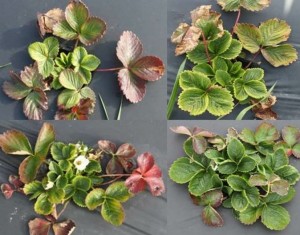by Andy Wyenandt and Peter Nitzsche
Strawberry mottle virus (SMoV) and strawberry mild yellow edge virus (SMYEV) have been found in Pennsylvania, Virginia and New Jersey this spring. Plants sourced from one particular nursery in the Great Valley area of Nova Scotia are at risk. Keep this in mind when ordering new plants for fall. Although the strawberry plant may show symptoms and yield less, fruit from infected plants are still edible and there should be no difference in taste.
For New Jersey
Morris County Agricultural Agent Peter Nitzsche collected samples from two northern NJ farms and sent samples to Bob Martin of USDA ARS. As suspected, several of the samples from small or stunted plants came back positive for both viruses and some large and small plants tested positive for one of the viruses.
What to Look For
These viruses are usually only a problem in matted-row strawberry production, where plants are in the field for a much longer period of time and plantings are not destroyed at the end of each growing season.
- Look for small, stunted plants with older leaves sometimes turning bright red in color, while the edges of leaves around the crowns of plants, and/or emerging leaves, show a distinct yellowing, which sometimes develop into patterns of marginal necrosis (i.e., dead tissue along the margins of leaves).
- Scout for aphids as they transmit both viruses.
 |
| Symptomatic Strawberry Plants Photo by Chuck Johnson, VA Tech |
What to Do
Scout for aphid vectors and spray appropriately following label recommendations. Plants known to be infected, or showing typical symptoms, or obtained from the nursery in question should be destroyed. If you have questions or concerns, contact your county agent.
[posted by Rabin]

